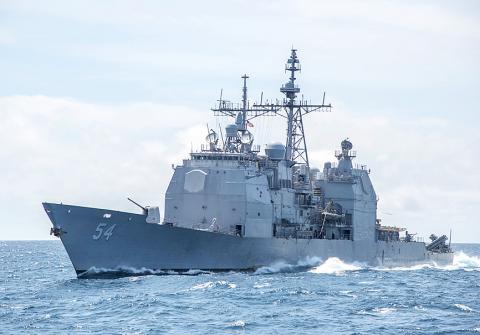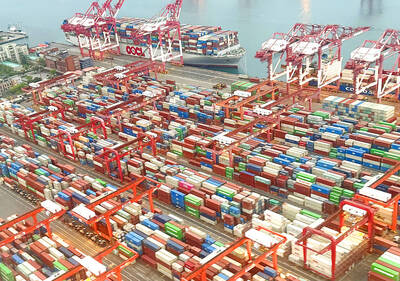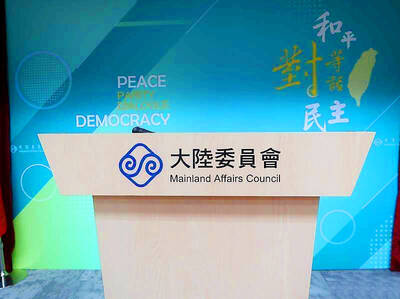The Ministry of National Defense yesterday confirmed that a US military vessel sailed through the Taiwan Strait, the 10th US vessel to make such a transit this year.
The ship entered the Strait from the southwest, heading north, the ministry said in a statement, but did not name the vessel, although Reuters identified it as the USS Antietam.
The passage of the US warship through the Strait constitutes freedom of navigation, the ministry said, adding that the nation’s military monitored the transit and there was no “abnormal activity.”

Photo: AP
The ship’s transit through the Strait demonstrates the US’ commitment to a free and open Indo-Pacific region, Reuters said, quoting a statement from US Pacific Fleet spokesman Clay Doss.
“The US Navy will continue to fly, sail and operate anywhere international law allows,” the statement said.
The passage of the US military vessel through the waterway separating Taiwan and China marked the sixth such operation this year.
The first occurred on Jan. 24, when the guided-missile destroyer USS McCampbell and the USNS Walter S. Diehl made similar passages.
The USS Stethem and USNS Cesar Chavez transited the Strait on Feb. 24, followed by the transit of the guided-missile destroyer USS Curtis Wilbur and the maritime security cutter USS Bertholf on March 24.
The USS William P. Lawrence and USS Stethem then traversed the Strait on April 28, followed by the transit of the destroyer USS Preble and USNS Walter S. Diehl on May 22.
US warships have sailed through the Strait at least once a month this year, except last month.
The voyage yesterday came amid heightened cross-strait tensions, as well as the ongoing trade dispute between Washington and Beijing.
China on Wednesday released its first defense white paper since 2012. The paper made it clear that the Chinese military would resolutely “oppose and contain Taiwan independence.”

CARROT AND STICK: While unrelenting in its military threats, China attracted nearly 40,000 Taiwanese to over 400 business events last year Nearly 40,000 Taiwanese last year joined industry events in China, such as conferences and trade fairs, supported by the Chinese government, a study showed yesterday, as Beijing ramps up a charm offensive toward Taipei alongside military pressure. China has long taken a carrot-and-stick approach to Taiwan, threatening it with the prospect of military action while reaching out to those it believes are amenable to Beijing’s point of view. Taiwanese security officials are wary of what they see as Beijing’s influence campaigns to sway public opinion after Taipei and Beijing gradually resumed travel links halted by the COVID-19 pandemic, but the scale of

TRADE: A mandatory declaration of origin for manufactured goods bound for the US is to take effect on May 7 to block China from exploiting Taiwan’s trade channels All products manufactured in Taiwan and exported to the US must include a signed declaration of origin starting on May 7, the Bureau of Foreign Trade announced yesterday. US President Donald Trump on April 2 imposed a 32 percent tariff on imports from Taiwan, but one week later announced a 90-day pause on its implementation. However, a universal 10 percent tariff was immediately applied to most imports from around the world. On April 12, the Trump administration further exempted computers, smartphones and semiconductors from the new tariffs. In response, President William Lai’s (賴清德) administration has introduced a series of countermeasures to support affected

Pope Francis is be laid to rest on Saturday after lying in state for three days in St Peter’s Basilica, where the faithful are expected to flock to pay their respects to history’s first Latin American pontiff. The cardinals met yesterday in the Vatican’s synod hall to chart the next steps before a conclave begins to choose Francis’ successor, as condolences poured in from around the world. According to current norms, the conclave must begin between May 5 and 10. The cardinals set the funeral for Saturday at 10am in St Peter’s Square, to be celebrated by the dean of the College

CROSS-STRAIT: The vast majority of Taiwanese support maintaining the ‘status quo,’ while concern is rising about Beijing’s influence operations More than eight out of 10 Taiwanese reject Beijing’s “one country, two systems” framework for cross-strait relations, according to a survey released by the Mainland Affairs Council (MAC) on Thursday. The MAC’s latest quarterly survey found that 84.4 percent of respondents opposed Beijing’s “one country, two systems” formula for handling cross-strait relations — a figure consistent with past polling. Over the past three years, opposition to the framework has remained high, ranging from a low of 83.6 percent in April 2023 to a peak of 89.6 percent in April last year. In the most recent poll, 82.5 percent also rejected China’s